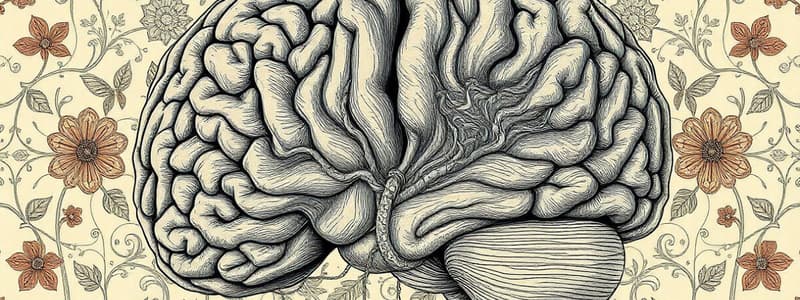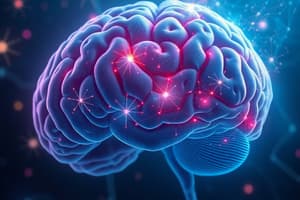Podcast
Questions and Answers
What is the primary role of Purkinje neurons?
What is the primary role of Purkinje neurons?
- Integrate sensory signals
- Facilitate motor coordination and balance (correct)
- Support signal transmission
- Provide nutrients to other neurons
What distinguishes glial cells from neurons?
What distinguishes glial cells from neurons?
- Their ability to transmit signals
- Their role in integrating sensory information
- Their larger size and branching structure
- Their supportive functions in the nervous system (correct)
Which of the following functions is NOT associated with astrocytes?
Which of the following functions is NOT associated with astrocytes?
- Maintaining the blood-brain barrier
- Providing nutrients to neurons
- Transmitting electrical signals between neurons (correct)
- Repairing the brain and spinal cord after injury
What is the primary function of the cerebrum?
What is the primary function of the cerebrum?
Which of the following statements about Purkinje neurons is true?
Which of the following statements about Purkinje neurons is true?
Which type of glial cell has a role in maintaining the blood-brain barrier?
Which type of glial cell has a role in maintaining the blood-brain barrier?
Which lobe of the brain is primarily responsible for processing visual information?
Which lobe of the brain is primarily responsible for processing visual information?
What connects the left and right cerebral hemispheres?
What connects the left and right cerebral hemispheres?
Which lobe of the brain is involved in planning and decision-making?
Which lobe of the brain is involved in planning and decision-making?
The parietal lobe is responsible for processing which type of information?
The parietal lobe is responsible for processing which type of information?
What is the primary function of the basal ganglia?
What is the primary function of the basal ganglia?
Which structure is responsible for relaying sensory information to the cerebral cortex?
Which structure is responsible for relaying sensory information to the cerebral cortex?
Where is the hypothalamus located in relation to the thalamus?
Where is the hypothalamus located in relation to the thalamus?
What role does the brainstem play in the body?
What role does the brainstem play in the body?
Which part of the brainstem is involved in regulating sleep and respiration?
Which part of the brainstem is involved in regulating sleep and respiration?
What is the primary function of the axon in a neuron?
What is the primary function of the axon in a neuron?
Where are axon terminals located and what is their role?
Where are axon terminals located and what is their role?
What structures wrap around the axon to form the myelin sheath?
What structures wrap around the axon to form the myelin sheath?
What is the function of the Node of Ranvier in a neuron?
What is the function of the Node of Ranvier in a neuron?
Which of the following correctly describes the role of dendrites?
Which of the following correctly describes the role of dendrites?
Flashcards
Axon Function
Axon Function
Transmits electrical signals away from the cell body.
Axon Terminal Function
Axon Terminal Function
Releases neurotransmitters for communication.
Cell Body (Soma) Function
Cell Body (Soma) Function
Integrates signals and generates outgoing signals.
Dendrite Function
Dendrite Function
Receives signals from other neurons.
Signup and view all the flashcards
Myelin Sheath Function
Myelin Sheath Function
Insulates axon, speeding signal.
Signup and view all the flashcards
Purkinje Neuron Function
Purkinje Neuron Function
Plays a role in motor coordination and balance in the cerebellum.
Signup and view all the flashcards
Glia Cell Role
Glia Cell Role
Supportive cells in the nervous system that provide structure, metabolism, and signal transmission assistance.
Signup and view all the flashcards
Astrocyte Location
Astrocyte Location
Star-shaped glial cells found in the central nervous system (CNS).
Signup and view all the flashcards
Astrocyte Function (1)
Astrocyte Function (1)
Maintain the blood-brain barrier.
Signup and view all the flashcards
Astrocyte Function (2)
Astrocyte Function (2)
Provide nutrients to neurons.
Signup and view all the flashcards
Cerebral Hemispheres
Cerebral Hemispheres
Two halves of the cerebrum, connected by the corpus callosum; each controls the opposite side of the body and has specialized functions.
Signup and view all the flashcards
Frontal Lobe Function
Frontal Lobe Function
Planning, decision-making, problem-solving, and voluntary movement; includes the motor cortex
Signup and view all the flashcards
Parietal Lobe
Parietal Lobe
Processes touch, temperature, and spatial awareness, located behind the frontal lobe.
Signup and view all the flashcards
Temporal Lobe Role
Temporal Lobe Role
Involved in hearing, memory, and language comprehension, located on the sides of the brain.
Signup and view all the flashcards
Occipital Lobe
Occipital Lobe
Processes visual information; Located at the back of the brain
Signup and view all the flashcards
Basal Ganglia Function
Basal Ganglia Function
The basal ganglia are a group of nuclei deep within the brain that control movement, habits, and rewards.
Signup and view all the flashcards
Diencephalon Role
Diencephalon Role
The diencephalon, sits above the brainstem and includes the thalamus, hypothalamus, and epithalamus, helping relay senses and maintain internal balance.
Signup and view all the flashcards
Thalamus Function
Thalamus Function
The thalamus acts as a sensory relay station, sending sensory information to the cerebral cortex.
Signup and view all the flashcards
Hypothalamus Control
Hypothalamus Control
The hypothalamus regulates body functions such as temperature, hunger, and autonomic functions.
Signup and view all the flashcards
Brainstem Connection
Brainstem Connection
The brainstem connects the brain and spinal cord. It controls life-sustaining functions such as breathing and heart rate.
Signup and view all the flashcardsStudy Notes
Brain Function and Structure
- The cerebrum is the largest part of the brain, divided into left and right hemispheres
- Hemispheres control higher brain functions such as thought, memory, and voluntary movement
- Cerebral hemispheres are connected by the corpus callosum, with each controlling opposite sides of the body and having specialized functions
- The cerebral cortex, the outer layer of the cerebrum, is composed of grey matter. It is involved in perception, reasoning, language, and voluntary movements
- The frontal lobe is located at the front of the brain. It's responsible for planning, decision-making, problem-solving, and voluntary movement. It also contains the motor cortex.
- The parietal lobe is located behind the frontal lobe. It processes sensory information, such as touch, temperature, and spatial awareness.
- The temporal lobes are located on the sides of the brain. They are involved in hearing, memory, and language comprehension
- The occipital lobe is located at the back of the brain. It processes visual information.
Studying That Suits You
Use AI to generate personalized quizzes and flashcards to suit your learning preferences.




